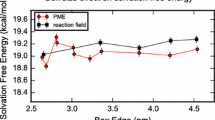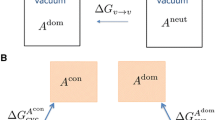Abstract
Small molecule distribution coefficients between immiscible nonaqueuous and aqueous phases—such as cyclohexane and water—measure the degree to which small molecules prefer one phase over another at a given pH. As distribution coefficients capture both thermodynamic effects (the free energy of transfer between phases) and chemical effects (protonation state and tautomer effects in aqueous solution), they provide an exacting test of the thermodynamic and chemical accuracy of physical models without the long correlation times inherent to the prediction of more complex properties of relevance to drug discovery, such as protein-ligand binding affinities. For the SAMPL5 challenge, we carried out a blind prediction exercise in which participants were tasked with the prediction of distribution coefficients to assess its potential as a new route for the evaluation and systematic improvement of predictive physical models. These measurements are typically performed for octanol-water, but we opted to utilize cyclohexane for the nonpolar phase. Cyclohexane was suggested to avoid issues with the high water content and persistent heterogeneous structure of water-saturated octanol phases, since it has greatly reduced water content and a homogeneous liquid structure. Using a modified shake-flask LC-MS/MS protocol, we collected cyclohexane/water distribution coefficients for a set of 53 druglike compounds at pH 7.4. These measurements were used as the basis for the SAMPL5 Distribution Coefficient Challenge, where 18 research groups predicted these measurements before the experimental values reported here were released. In this work, we describe the experimental protocol we utilized for measurement of cyclohexane-water distribution coefficients, report the measured data, propose a new bootstrap-based data analysis procedure to incorporate multiple sources of experimental error, and provide insights to help guide future iterations of this valuable exercise in predictive modeling.



Similar content being viewed by others
Notes
Shimadzu Cat. No. 228-45450-91.
DMSO stocks from Genentech compound library.
ACS grade \(\ge\)99 %, Sigma-Aldrich Cat. No 179191-2L, batch #00555ME.
136 mM NaCl, 2.6 mM KCl, 7.96 mM \(\hbox {Na}_2\hbox {HPO}_4\), 1.46 mM \(\hbox {KH}_2\hbox {PO}_4\), with pH adjusted to 7.4, prepared by the Genentech Media lab.
Thermo Fisher Scientific, Titer Plate Shaker, model: 4625,Waltham, MA, USA.
Agilent Technologies, Vial plate for holding 54 × 2 mL vials part no. G2255-68700.
Eppendorf, Centrifuge 5804, Hamburg, Germany.
384-well glass coat plate:Thermo Scientific, Microplate, 384-Well; Webseal Plate; Glass-coated Polypropylene; Square well shape; U-Shape well bottom; 384 wells; 90 uL sample volume; Catalog Number: 3252187.
ACROS Organics, 1-octanol 99 % pure, Catalog Number: AC150630010, Geel, Belgium.
Waters Xbridge C18 2.130 mm with 2.5 m particles.
Agilent Cat No 24214-001.
All LC solvents were HPLC-grade and purchased from OmniSolv (Charlotte, NC, USA).
This was done using a Shimadzu NexeraX2 consisting of an LC-30AD(pump), SIL-30AC (auto-injector), and SPD-20AC(UV/VIS detector) with Sciex API4000QTRP (MS).
This was done using a Shimadzu NexeraX2 consisting of an LC-30AD(pump), SIL-30AC (auto-injector), and SPD-20AC(UV/VIS detector) with Sciex API4000 (MS).
For the purpose of the D3R/SAMPL5 workshop, we originally erroneously reported the standard deviation \(\cdot \sqrt{3}\) instead of the standard error \(\cdot \sqrt{3}\). The factor of \(\sqrt{3}\) corrects the sample standard deviation across all MRM measurements for the correlation between the 3 replicate measurements belonging to a single independent experimental repeat.
Abbreviations
- SAMPL:
-
Statistical assessment of the modeling of proteins and ligands
- log P:
-
\(\log _{10}\) partition coefficient
- log D:
-
\(\log _{10}\) distribution coefficient
- LC-MS/MS:
-
Liquid chromatography - tandem mass spectrometry
- HPLC:
-
High-pressure liquid chromatography
- MRM:
-
Multiple reaction monitoring
- PTFE:
-
Polytetrafluoroethylene
- DMSO:
-
Dimethyl sulfoxide
- PBS:
-
Phosphate buffered saline
- RPM:
-
Revolutions per minute
- CV:
-
Coefficient of variation
- MAP:
-
Maximum a posteriori
- MCMC:
-
Markov chain Monte Carlo
References
Guthrie JP (2009) J Phys Chem B 113:4501
Geballe MT, Skillman AG, Nicholls A, Guthrie JP, Taylor PJ (2010) J Comput Aided Mol Des 24:259
Skillman AG (2012) J Comput Aided Mol Des 26:473
Muddana HS, Fenley AT, Mobley DL, Gilson MK (2014) J Comput Aided Mol Des 28:305
Mobley DL, Wymer KL, Lim NM, Guthrie JP (2014) J Comput Aided Mol Des 28:135
Czodrowski P, Sotriffer CA, Klebe G (2007) J Mol Biol 367:1347
Steuber H, Czodrowski P, Sotriffer CA, Klebe G (2007) J Mol Biol 373:1305
Martin YC (2009) J Comput Aid Mol Des 23:693
Mannhold R, Poda GI, Ostermann C, Tetko IV (2009) J Pharm Sci 98:861
Kollman PA (1996) Acc Chem Res 29:461
Best SA, Merz KM, Reynolds CH (1999) J Phys Chem B 103:714
Chen B, Siepmann JI (2006) J Phys Chem B 110:3555
Lyubartsev AP, Jacobsson SP, Sundholm G, Laaksonen A (2001) J Phys Chem B 105:7775
Bhatnagar N, Kamath G, Chelst I, Potoff JJ (2012) J Pharm Sci 137:014502
Margolis SA, Levenson M (2000) Fresenius’ J Anal Chem 367:1
Stephenson R, Stuart J, Tabak M (1984) J Chem Eng Data 29:287
Black C, Joris GG, Taylor HS (1948) J Chem Phys 16:537
Yalkowsky SH, He Y, Jain P (2010) Handbook of aqueous solubility data. CRC Press, Boca Raton
Harris JG, Stillinger FH (1991) J Chem Phys 95:5953
Bannan CC, Burley KH, Chiu M, Shirts MR, Gilson MK, Mobley DL (2016) J Comput Aided Mol Des. doi:10.1007/s10822-016-9954-8
Lin B, Pease JH (2013) Comb Chem High Throughput Screen 16:817
Haynes WM (2014) CRC handbook of chemistry and physics. CRC Press, Boca Raton
Leo A, Hansch C, Elkins D (1971) Chem Rev 71:525
Milletti F, Storchi L, Sforna G, Cruciani G (2007) J Chem Inf Model 47:2172
Milletti F, Storchi L, Goracci L, Bendels S, Wagner B, Kansy M, Cruciani G (2010) Eur J Med Chem 45:4270
Efron B (1979) Ann Stat 7:1
Hanson SM, Ekins S, Chodera JD (2015) J Comput-Aided Mol Des 29:1073
Efron B, Tibshirani RJ (1994) An introduction to the bootstrap. CRC Press, Boca Raton
Rainin Pipet-Lite Multi Pipette L8-200XLS+. https://www.shoprainin.com/Pipettes/Multichannel-Manual-Pipettes/Pipet-Lite-XLS%2B/Pipet-Lite-Multi-Pipette-L8-200XLS%2B/p/17013805. Accessed 06 June 2016
Rainin Classic Pipette PR-10. https://www.shoprainin.com/Pipettes/Single-Channel-Manual-Pipettes/RAININ-Classic/Rainin-Classic-Pipette-PR-10/p/17008649. Accessed 06 June 2016
Rosenblatt M (1956) Ann Math Stat 27:832
Drewokane MWOB, Hobson P, Halchenko Y, Lukauskas S, Warmenhoven J, Cole JB, Hoyer S, Vanderplas J, Villalba S, Quintero E, Martin M, Miles A, Meyer K, Augspurger T, Yarkoni T, Bachant P, Evans C, Fitzgerald C, Nagy T, Ziegler E, Megies T, Wehner D, St-Jean S, Coelho LP, Hitz G, Lee A, Rocher L (2016) seaborn: v0.7.0 (January 2016)
Nicholls A (2014) J Comput-Aided Mol Des 28:887
J Chem Eng Data 12, 326 (1967)
Speight JG et al (2005) Lange’s handbook of chemistry, vol 1. McGraw-Hill, New York
Klamt A, Eckert F, Reinisch J, Wichmann K (2016) J Comput Aided Mol Des. doi:10.1007/s10822-016-9927-y
Hastings WK (1970) Biometrika 57:97
Acknowledgments
The authors acknowledge Christopher Bayly (OpenEye Scientific) and Robert Abel (Schrödinger) for their contributions to discussions on compound selection; Joseph Pease (Genentech) for discussions of the experimental approach and aid in compound selection; Delia Li (Genentech) for her assistance in performing experimental work; Alberto Gobbi (Genentech), Man-Ling Lee (Genentech), and Ignacio Aliagas (Genentech) for helpful feedback on experimental issues; Andreas Klamt (Cosmologic) and Jens Reinisch (Cosmologic) for invigorating discussions regarding experimental data; Patrick Grinaway (MSKCC) for helpful discussions on analysis procedures; and Anthony Nicholls (OpenEye) for originating and supporting earlier iterations of SAMPL challenges.
Funding
This work was performed as part of an internship by ASR sponsored by Genentech, Inc., 1 DNA Way, South San Francisco, CA 94080, United States. JDC acknowledges support from the Sloan Kettering Institute and NIH grant P30 CA008748. DLM appreciates financial support from National Science Foundation (CHE 1352608).
Author information
Authors and Affiliations
Corresponding author
Ethics declarations
Conflict of interest statement
D. L. M. and J. D. C. are members of the Scientific Advisory Board for Schrödinger, LLC.
Electronic supplementary material
Below is the link to the electronic supplementary material.
Rights and permissions
About this article
Cite this article
Rustenburg, A.S., Dancer, J., Lin, B. et al. Measuring experimental cyclohexane-water distribution coefficients for the SAMPL5 challenge. J Comput Aided Mol Des 30, 945–958 (2016). https://doi.org/10.1007/s10822-016-9971-7
Received:
Accepted:
Published:
Issue Date:
DOI: https://doi.org/10.1007/s10822-016-9971-7




